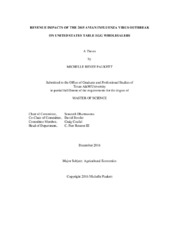| dc.description.abstract | From December 2014 to June 2015, the U.S. poultry industry experienced an outbreak of highly pathogenic avian influenza (HPAI), resulting in massive bird depopulations. Both turkey and egg producers were impacted and farms affected faced losses from costs of bird disposal and farm repopulation. This study isolates the table egg subsector of the poultry industry and looks at the revenue impact of the AI outbreak at the wholesale level. To determine this revenue impact, a vector error correction model (VECM) was defined and used to generate the counterfactual revenue during the time period the outbreak occurred. This counterfactual revenue was compared to the actual revenue observed during that time period and the difference is the revenue impact due to the outbreak, ceteris paribus. Additionally, machine learning algorithms, using residuals from the VECM, allowed us to determine causal relationships in contemporaneous time among the variables considered within the industry. The results from this study provide us with a better understanding of the table egg industry based on sound econometric modeling and provide a basis for conducting future revenue impact studies for similar events.
Our model was developed using eight variables defined by previous studies including the number of hens and eggs, egg price, feed input prices, retail pork and beef prices, and real disposable personal income. After rigorous testing using RATS software, the vector error correction model for forecasting was identified with one lag and two cointegrating vectors. When the counterfactual revenue was compared to the actual revenue from December 2014 to June 2015, a gain of about $676 million to wholesalers was determined to be attributed to the outbreak. Additionally, residual analysis of contemporaneous relationships, as shown by directed acyclic graphs, indicated that egg price is independent of direct production quantities, hens and eggs, but is impacted by production costs such as feed input costs. These results can be accounted for by various factors including the inelasticity of egg price and the imperfectly competitive behavior of the wholesalers. Future studies can use price transmission principles to expand this study and identify AI outbreak impacts at the consumer and producer levels. | en |


